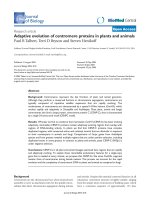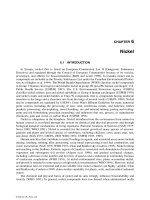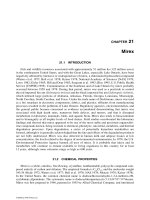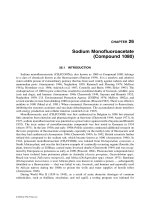classifying plants and animals
Bạn đang xem bản rút gọn của tài liệu. Xem và tải ngay bản đầy đủ của tài liệu tại đây (4.87 MB, 14 trang )
by Camille La Vouché
Scott Foresman Science 4.1
Genre Comprehension Skill Text Features Science Content
Nonfi ction Compare and
Contrast
• Labels
• Captions
• Charts
• Glossary
Classifying Plants
and Animals
ISBN 0-328-13859-2
ì<(sk$m)=bdifjd< +^-Ä-U-Ä-U
Life Science
13859_CVR_FSD Cover113859_CVR_FSD Cover1 5/26/05 10:24:32 AM5/26/05 10:24:32 AM
by Camille La Vouché
Scott Foresman Science 4.1
Genre Comprehension Skill Text Features Science Content
Nonfi ction Compare and
Contrast
• Labels
• Captions
• Charts
• Glossary
Classifying Plants
and Animals
ISBN 0-328-13859-2
ì<(sk$m)=bdifjd< +^-Ä-U-Ä-U
Life Science
13859_CVR_FSD Cover113859_CVR_FSD Cover1 5/26/05 10:24:32 AM5/26/05 10:24:32 AM
Vocabulary
cell
chloroplast
cytoplasm
genus
invertebrates
nucleus
species
vertebrates
What did you learn?
1. What parts does a plant cell have that an animal cell
does not have?
2. What are six kingdoms used for classification?
3. How does an animal get its scientific name?
4.
Animals have adaptations
to help them survive in their environment. Describe on
your own paper adaptations that some animals have to
protect themselves from predators. Use examples from
the book to support your answer.
5.
Compare and Contrast How are vascular and
nonvascular plants the same? How are they different?
Illustration: 5 Robert Ulrich
Photographs: Every effort has been made to secure permission and provide appropriate credit for
photographic material. The publisher deeply regrets any omission and pledges to correct errors called to its
attention in subsequent editions. Unless otherwise acknowledged, all photographs are the property of Scott
Foresman, a division of Pearson Education. Photo locators denoted as follows: Top (T), Center (C), Bottom
(B), Left (L), Right (R) Background (Bkgd)
Opener: ©Zig Leszczynski/Animals Animals/Earth Scenes; Title Page: ©John Conrad/Corbis; 4 (CL)
©Carolina Biological/Visuals Unlimited, (BL) ©SIU/Visuals Unlimited, (BR) ©Alfred Pasieka/Photo
Researchers, Inc.; 6 (CR) ©Stephen Dalton/NHPA Limited, (BR) Getty Images; 7 (TL) ©T. Beveridge/
Visuals Unlimited, (TC) ©L. Stannard/Photo Researchers, Inc., (TR) ©Eric Grave/Phototake, (BL) Getty
Images, (BC) ©Craig Tuttle/Corbis, (BR) ©Ken Cole/Animals Animals/Earth Scenes; 8 (CL) Getty Images,
(BL) ©Kevin Schafer/Corbis; 9 (TL) Getty Images, (TL) ©Ken Cole/Animals Animals/Earth Scenes, (TC)
©John Conrad/Corbis, (TR, TC, B) ©DK Images, (TC) ©Ray Richardson/Animals Animals/Earth Scenes,
(TL) ©Kevin Schafer/Corbis; 10 (L) Sue Atkinson/©DK Images, (BL) ©John Durham/Photo Researchers,
Inc.; 11 (TL) Karl Shone/©DK Images, (BL) ©DK Images, (CL) Lee W. Wilcox; 12 (CR) Getty Images, (BR)
©DK Images; 13 ©Wolfgang Kaehler/Corbis; 14 (CL) Getty Images, (CL) ©Jane Burton/DK Images, (CL,
BL) ©DK Images, (BL) ©Ray Richardson/Animals Animals/Earth Scenes; 15 (CL, BR) ©DK Images; 16 (CL,
BC) ©DK Images, (TR) ©Jim Tuten/Animals Animals/Earth Scenes; 17 (T, BL) ©DK Images; 18 (CL) ©DK
Images, (BL) ©Andrew Syred/Photo Researchers, Inc., (BC) Jerry Young/©DK Images, (BR)
©F. J. Jackson/Robert Harding Picture Library Ltd., (CR) Dave King/©DK Images; 19 (CL, BR, BL) ©Dwight
R. Kuhn, (CR) ©Chase Swift/Corbis; 20 ©DK Images; 21 (CL) ©Ray Richardson/Animals Animals/
Earth Scenes, (BR) ©DK Images; 22 (BR) ©Ralph A. Clevenger/Corbis, (TR) ©Ray Richardson/Animals
Animals/Earth Scenes; 23 ©Anup Shah/Nature Picture Library.
ISBN: 0-328-13859-2
Copyright © Pearson Education, Inc.
All Rights Reserved. Printed in the United States of America. This publication is
protected by Copyright and permission should be obtained from the publisher prior
to any prohibited reproduction, storage in a retrieval system, or transmission in any
form by any means, electronic, mechanical, photocopying, recording, or likewise. For
information regarding permissions, write to: Permissions Department, Scott Foresman,
1900 East Lake Avenue, Glenview, Illinois 60025.
3 4 5 6 7 8 9 10 V010 13 12 11 10 09 08 07 06 05
13859_CVR_FSD Sec1:213859_CVR_FSD Sec1:2 5/26/05 10:24:41 AM5/26/05 10:24:41 AM
Classifying Plants
and Animals
by Camille La Vouché
13859_01-24_FSD 113859_01-24_FSD 1 5/26/05 2:24:16 PM5/26/05 2:24:16 PM
2
What are the building blocks
of life?
What Cells Are
A cell is the smallest unit of a living thing. A cell can carry
out life functions. All living things are made of cells. Some
are made of one cell. Plants and animals have many
cells. Cells are the building blocks of life.
Cells have jobs. Cells can help a living thing use
energy, grow, and reproduce. Some cells keep a
living thing healthy. Cells can develop only from
other cells.
You can use microscopes to see cells. A
microscope makes objects look bigger than
they are. Scientists look at cells through a
microscope. Then they learn many things
about cells.
A microscope helps
scientists see the
details of a cell.
13859_01-24_FSD 213859_01-24_FSD 2 5/26/05 2:24:18 PM5/26/05 2:24:18 PM
3
The Parts of a Cell
Animals such as eagles and elephants do not look alike.
They are made of cells. These cells have parts that are alike.
Each part of a cell has a job.
Plant cells and animal cells have a nucleus, cytoplasm,
and a cell membrane. The nucleus tells the cell what to do.
Cytoplasm is a gel-like material. It has what the cell needs
to do its job. The cell membrane is the border of the cell. It
separates the cell from what is outside of it.
Cell membrane
Nucleus
Cytoplasm
The size and shape of a cell are
related to the cell’s job.
13859_01-24_FSD 313859_01-24_FSD 3 5/26/05 2:24:20 PM5/26/05 2:24:20 PM
4
Cells Working Together
Cells are organized into groups. Different groups of cells do
different jobs.
Cells that do the same job form tissues. A group of tissues
that work together forms an organ. The heart is an organ.
Organs that work together to do a job are called organ systems.
The heart is one part of an organ system.
An organism is a complete living thing. It is the highest level
of cell organization.
A group of one kind of cell is a tissue.
Each kind of tissue does a certain job.
Many organs work together
in an organ system. The heart,
blood, and blood vessels are
some parts of one system.
A group of tissues
that work together is
an organ. The heart
is one organ in an
animal.
13859_01-24_FSD 413859_01-24_FSD 4 5/26/05 2:24:22 PM5/26/05 2:24:22 PM
5
Plant cells have parts that animal cells do not have. Plant
cells have chloroplasts. A chloroplast traps energy from the
Sun. This energy helps the plant make its own food.
Each plant cell has a cell wall. The cell wall is a layer outside
the cell membrane. It supports the plant cell. It also protects the
plant cell.
Cell membrane
Cytoplasm
Nucleus
Cell wall
Chloroplast
A Plant Cell
13859_01-24_FSD 513859_01-24_FSD 5 5/26/05 2:24:25 PM5/26/05 2:24:25 PM
6
How are living things
grouped?
Classification Systems
Scientists sort living things into groups. Organisms in the
same group have things in common.
Kingdoms
A kingdom is the largest
classification group. Many
scientists classify organisms into
six kingdoms.
Answer these questions to see
if a dandelion and a mushroom
are in the same kingdom. How
many cells does the organism
have? Where does it live? How
does it get food?
They both have more than one
cell. They both live on land and
grow in soil. A dandelion makes
its own food. A mushroom takes
in food from other things.
Dandelions and mushrooms
are alike in some ways. But they do
not get their food in the same way.
They are not in the same kingdom.
Mushrooms
Dandelions
13859_01-24_FSD 613859_01-24_FSD 6 5/26/05 2:24:28 PM5/26/05 2:24:28 PM
7
Kingdoms of Living Things
Ancient Bacteria
Ancient bacteria
are made of one
cell. They have no
separate nucleus.
They live in water or
on land. They make
their own food.
True Bacteria
True bacteria have
one cell. They have
no separate nucleus.
They live in water or
on land. Some get
food. Others make
their own food.
Protists
Most protists have
one cell. They have
a nucleus and other
cell parts. Some get
food. Others make
their own. Algae
and paramecia are
protists.
Fungi
Fungi have many
cells. Each cell has
a nucleus and other
parts. Fungi absorb
food from other living
or nonliving things.
They live on land.
Mushrooms are fungi.
Plants
Plants have many
cells. Each cell has
a nucleus and other
parts. The cells form
tissues and organs.
Plants live on land
or in water. They
use sunlight to make
food. Dandelions are
plants.
Animals
Animals have many
cells. The cells make
up tissues, organs,
and organ systems.
Animals live in water
or on land. They
eat plants and other
animals.
13859_01-24_FSD 713859_01-24_FSD 7 5/26/05 2:24:47 PM5/26/05 2:24:47 PM
8
Getting More Specific
Kingdoms are made up of smaller groups. Each group is then
divided into smaller and smaller groups. Scientists use features
of an organism to put it into groups.
Genus and species are the two smallest groups. They make
up an organism’s scientific name. A genus is a group of closely
related plants or animals. A species is a group of similar
organisms that can mate and produce offspring. The species
name usually comes from a feature, such as the color of the
organism or where it lives.
Members of the Cat Family
Most scientific names are Latin words. An animal’s scientific
name is the same all over the world. The house cat and the
black-footed cat are both in the Felis genus. But they are
different species. The house cat’s species is domesticus, or “of the
house.” The black-footed cat’s species is nigripes, or “black feet.”
The scientific name of
this house cat is Felis
domesticus.
The scientific name of
this black-footed cat is
Felis nigripes.
13859_01-24_FSD 813859_01-24_FSD 8 5/26/05 2:24:53 PM5/26/05 2:24:53 PM
9
Species
Kingdom
Division
Class
Order
Family
The Animal Kingdom
Genus
13859_01-24_FSD 913859_01-24_FSD 9 5/26/05 2:24:55 PM5/26/05 2:24:55 PM
10
The tissues of this bamboo
slice can only be seen with
a microscope.
Tubelike structures
How are plants
classified?
How Plants Transport Water
And Nutrients
Bamboo is very tall. How do the
cells at the top of this tall plant get
water and nutrients from the soil? The
plant has tubelike structures. The tubes
bring water and nutrients to every part
of the plant. Plants that have these
tubes are called vascular plants. Grass,
dandelions, and trees are vascular
plants.
Vascular tissue also supports the
plant’s stems and leaves. The plant is
able to grow larger.
13859_01-24_FSD 1013859_01-24_FSD 10 5/26/05 2:25:22 PM5/26/05 2:25:22 PM
11
More Down-to-Earth Plants
Plants that do not have tubelike structures
are nonvascular plants. They cannot grow
very tall. They do not have real roots, stems,
or leaves. Water and nutrients move from
one cell to the next cell.
Liverworts
Liverworts grow on moist rocks or
soil by streams. Some have a spicy
smell. Some look like flat leaves.
Some have the shape of a liver.
Hornworts
Hornworts do not have true
stems or leaves. They tend to live
in warm places.
Mosses
Mosses are the largest group of
nonvascular plants. They make
their own food. Some can live in
low temperatures.
13859_01-24_FSD 1113859_01-24_FSD 11 5/26/05 2:25:27 PM5/26/05 2:25:27 PM
12
How Plants Make New Plants
Scientists also classify plants by how they reproduce, or make
new plants. Some plants reproduce using seeds. Other plants
reproduce using spores.
Flowers and Seeds
Many plants with flowers or cones
make seeds. A seed has a young plant
and food inside of it. Most seeds come
from flowering plants. Seeds can have
different shapes and sizes. A cactus,
a fruit tree, and a poppy are
flowering plants.
Cones and Seeds
Conifers are plants that make seeds
without flowers. Conifers can grow cones.
Some cones make pollen. Some cones make
seeds. Evergreen plants are conifers. They
do not lose their leaves, or needles, during
the year.
The pod of a soybean holds
two or three seeds or beans.
A pine cone holds the seeds
and pollen of a conifer.
13859_01-24_FSD 1213859_01-24_FSD 12 5/26/05 2:25:30 PM5/26/05 2:25:30 PM
Spores
Ferns and mosses are plants that do not make seeds. They
make tiny cells. The tiny cells become new plants. These cells
are called spores. A spore might become a new plant if it falls
into a shady, moist place. It will get nutrients there.
Spore cases look like brown dots or streaks under a fern’s
leaves. The spore cases hold hundreds of spores.
13
The spots on this fern leaf
are groups of spore cases.
13859_01-24_FSD 1313859_01-24_FSD 13 5/26/05 2:25:32 PM5/26/05 2:25:32 PM
14
How are animals classified?
Animals with Backbones
The animal kingdom is made up of two groups. Animals that
have backbones are in one group. They are called vertebrates.
There are five kinds of vertebrates.
Birds Birds have feathers. They usually live on land.
Many birds spend much time in water. Birds use
lungs to breathe. They are warm-blooded. All birds
lay eggs.
Mammals Mammals have hair or fur. Most live on land.
A few live in water. They breathe with lungs.
Mammals are warm-blooded; they make their own
heat. Most mammals have live births.
Reptiles Reptiles have scales. Most reptiles live on land.
Some can live in water. They use lungs to breathe.
Reptiles are cold-blooded. They usually lay eggs.
Amphibians Amphibians are covered with skin. They can live on
land and in the water. To breathe, they use lungs
or gills or both. They are cold-blooded. Amphibians
hatch from eggs.
Fish Fish usually have scales. They live only in
water. Fish get oxygen mostly with gills.
Fish are cold-blooded. Most lay eggs.
Vertebrates
13859_01-24_FSD 1413859_01-24_FSD 14 5/26/05 2:25:40 PM5/26/05 2:25:40 PM
15
Reptiles
Reptiles are one group of vertebrates. They live in water and
on land. Alligators, crocodiles, snakes, lizards, and turtles are
reptiles. Reptiles have lungs for breathing. Their dry skin has
scales or plates all over.
Alligators and crocodiles look alike. But they are different.
The long teeth in an alligator’s bottom jaw cannot be seen
when its mouth is shut. A crocodile’s teeth can be seen when its
mouth is shut.
The python has a very
long backbone.
13859_01-24_FSD 1513859_01-24_FSD 15 5/26/05 2:25:54 PM5/26/05 2:25:54 PM
16
Life Cycle of a Reptile
The Burmese python is a long, thick snake. It can be
six meters (about twenty feet) long. It is not poisonous. It uses
heat sensors on its upper lip to find food. It has a strong sense
of smell. A python squeezes its prey and swallows it whole. The
Burmese python can swallow animals whose bodies are larger
than its own head.
A female python can lay
as many as 100 eggs.
The mother
python wraps
herself around
her eggs to keep
them warm.
The young python
hatches in about six
to eight weeks.
13859_01-24_FSD 1613859_01-24_FSD 16 5/26/05 2:26:07 PM5/26/05 2:26:07 PM
17
Soon the mother leaves,
and the young python
must care for itself.
The python grows and
reproduces. It can live
as long as 25 years.
13859_01-24_FSD 1713859_01-24_FSD 17 5/26/05 2:26:14 PM5/26/05 2:26:14 PM
18
Scientists have identified
more than one million
species of invertebrates.
Earthworm
Tapeworm
Clam
Sponge
Crab
Invertebrates
Invertebrates
Animals with no backbones are called invertebrates.
Jellyfish, worms, spiders, snails, and clams are invertebrates.
They have soft bodies.
Arthropods and More
Arthropods are animals with jointed legs. They are the
largest group of invertebrates. Their legs and bodies are in
sections. Insects, spiders, and crabs are arthropods. They
have a hard, lightweight outer skin called an exoskeleton.
Spiders
Spiders are arthropods. They have eight legs. They have two
main body parts. They can spin silk. Most spiders use this silk to
make webs. Webs trap their prey.
13859_01-24_FSD 1813859_01-24_FSD 18 5/26/05 2:26:20 PM5/26/05 2:26:20 PM
1. The brown garden snail
lays its eggs.
2. The eggs hatch in two to
four weeks.
4. Adult snails reproduce and
the life cycle begins again.
3. Newly hatched snails must
find food to grow.
Mollusks
A snail is a mollusk. It has a muscular structure called
a foot. The foot oozes a slimy liquid. This helps the snail
move. Some mollusks, such as oysters, do not move far. Some
are good swimmers.
The largest invertebrate is the giant squid. It can be
15 meters, or 50 feet, long.
The Life Cycle of the Brown Snail
Mother snails dig nests to lay eggs. They can lay 85 eggs in
a nest. The eggs hatch in two to four weeks. A newly-hatched
snail has to get its own food. First, it will eat its own eggshell.
It will then eat other eggs. Snails live for about ten years.
19
13859_01-24_FSD 1913859_01-24_FSD 19 5/26/05 2:26:41 PM5/26/05 2:26:41 PM
20
How do animals adapt?
How Animals Get What They Need
Young animals inherit traits, or physical features, from their
parents. A physical feature or behavior that helps an animal
survive and reproduce is an adaptation. All animals need food,
water, oxygen, and shelter. Animals that adapt well have a
better chance to survive and reproduce.
Birds’ Adaptations
Birds have feathers to
help them fly. The shape
of birds’ beaks helps
them get food. Ducks
have webbed feet to
help them swim.
Other Adaptations
Polar bears have thick coats
of fur to keep them warm. They
have sharp teeth and claws to
catch and hold food.
13859_01-24_FSD 2013859_01-24_FSD 20 5/26/05 2:26:47 PM5/26/05 2:26:47 PM
21
Adaptations that Protect Animals
An animal’s color can help it blend into its surroundings.
This helps it hide from predators. A bright color can mean an
animal is poisonous. Some animals have quills or hard shells
for protection.
Blending In
Colors, shapes, and patterns can hide an animal. The rock
ptarmigan has dark feathers in the summer. In the winter it has
white feathers. It blends with the snow.
Rock ptarmigan in winter
Protected by Poison
Some frogs and toads use poison for protection.
The poison-dart frog’s bright colors tell predators
that it is dangerous. It can produce enough poison
to kill a human!
Escaping Predators
Animals move in many ways to protect themselves. Birds’
wings help them fly away from predators. Fish have fins that
help them swim away. Some animals can run for a long time.
Rock ptarmigan in summer
13859_01-24_FSD 2113859_01-24_FSD 21 5/26/05 2:26:51 PM5/26/05 2:26:51 PM
22
Animal Instincts
Instincts are behaviors that animals inherit from parents.
Instincts help animals meet their needs. Ducklings have
the instinct to follow their mother. This is how they get food
and protection.
Migration
Food can be hard to find in
places where the winter is cold.
Migration is traveling to find food
or a place to reproduce.
Migration can be difficult. Some amphibians
may have to cross busy roads when they migrate.
Some animals must travel long distances to escape
the cold winter.
Hibernation and Inactivity
Some animals become inactive during very cold weather.
This inactivity is called hibernation. It is an instinct. Some
hibernating animals save energy by moving very little.
Others do not move at all.
Bear
hibernating
Canada geese
migrating
13859_01-24_FSD 2213859_01-24_FSD 22 5/26/05 2:26:54 PM5/26/05 2:26:54 PM
How Animals Learn
Some behavior must be learned. Young animals learn
by watching their parents or other adults.
Parents Teach Offspring
Young animals can learn to hunt by watching their parents.
A young lion practices pouncing on prey by pouncing on its
mother’s tail.
Offspring Teach Parents
Some adult animals learn from their young. A young
monkey taught adult monkeys how to wash sand off their food.
Learned and Inherited
Some behaviors are inherited and learned. The white-crowned
sparrow is born knowing how to sing. But it must learn the
song its species sings.
23
13859_01-24_FSD 2313859_01-24_FSD 23 5/26/05 2:27:05 PM5/26/05 2:27:05 PM
24
Glossary
cell the smallest unit of a living thing that can
carry out all life functions
chloroplast the part of a plant cell that traps energy from
the Sun
cytoplasm the gel-like substance in a cell that has what
the cell needs to do its job
genus a group of closely related living things
invertebrates animals without backbones
nucleus the control center of a cell
species a group of similar organisms that can mate
and produce offspring
vertebrates animals with backbones
13859_01-24_FSD 2413859_01-24_FSD 24 5/26/05 2:27:11 PM5/26/05 2:27:11 PM
Vocabulary
cell
chloroplast
cytoplasm
genus
invertebrates
nucleus
species
vertebrates
What did you learn?
1. What parts does a plant cell have that an animal cell
does not have?
2. What are six kingdoms used for classification?
3. How does an animal get its scientific name?
4.
Animals have adaptations
to help them survive in their environment. Describe on
your own paper adaptations that some animals have to
protect themselves from predators. Use examples from
the book to support your answer.
5.
Compare and Contrast How are vascular and
nonvascular plants the same? How are they different?
Illustration: 5 Robert Ulrich
Photographs: Every effort has been made to secure permission and provide appropriate credit for
photographic material. The publisher deeply regrets any omission and pledges to correct errors called to its
attention in subsequent editions. Unless otherwise acknowledged, all photographs are the property of Scott
Foresman, a division of Pearson Education. Photo locators denoted as follows: Top (T), Center (C), Bottom
(B), Left (L), Right (R) Background (Bkgd)
Opener: ©Zig Leszczynski/Animals Animals/Earth Scenes; Title Page: ©John Conrad/Corbis; 4 (CL)
©Carolina Biological/Visuals Unlimited, (BL) ©SIU/Visuals Unlimited, (BR) ©Alfred Pasieka/Photo
Researchers, Inc.; 6 (CR) ©Stephen Dalton/NHPA Limited, (BR) Getty Images; 7 (TL) ©T. Beveridge/
Visuals Unlimited, (TC) ©L. Stannard/Photo Researchers, Inc., (TR) ©Eric Grave/Phototake, (BL) Getty
Images, (BC) ©Craig Tuttle/Corbis, (BR) ©Ken Cole/Animals Animals/Earth Scenes; 8 (CL) Getty Images,
(BL) ©Kevin Schafer/Corbis; 9 (TL) Getty Images, (TL) ©Ken Cole/Animals Animals/Earth Scenes, (TC)
©John Conrad/Corbis, (TR, TC, B) ©DK Images, (TC) ©Ray Richardson/Animals Animals/Earth Scenes,
(TL) ©Kevin Schafer/Corbis; 10 (L) Sue Atkinson/©DK Images, (BL) ©John Durham/Photo Researchers,
Inc.; 11 (TL) Karl Shone/©DK Images, (BL) ©DK Images, (CL) Lee W. Wilcox; 12 (CR) Getty Images, (BR)
©DK Images; 13 ©Wolfgang Kaehler/Corbis; 14 (CL) Getty Images, (CL) ©Jane Burton/DK Images, (CL,
BL) ©DK Images, (BL) ©Ray Richardson/Animals Animals/Earth Scenes; 15 (CL, BR) ©DK Images; 16 (CL,
BC) ©DK Images, (TR) ©Jim Tuten/Animals Animals/Earth Scenes; 17 (T, BL) ©DK Images; 18 (CL) ©DK
Images, (BL) ©Andrew Syred/Photo Researchers, Inc., (BC) Jerry Young/©DK Images, (BR)
©F. J. Jackson/Robert Harding Picture Library Ltd., (CR) Dave King/©DK Images; 19 (CL, BR, BL) ©Dwight
R. Kuhn, (CR) ©Chase Swift/Corbis; 20 ©DK Images; 21 (CL) ©Ray Richardson/Animals Animals/
Earth Scenes, (BR) ©DK Images; 22 (BR) ©Ralph A. Clevenger/Corbis, (TR) ©Ray Richardson/Animals
Animals/Earth Scenes; 23 ©Anup Shah/Nature Picture Library.
ISBN: 0-328-13859-2
Copyright © Pearson Education, Inc.
All Rights Reserved. Printed in the United States of America. This publication is
protected by Copyright and permission should be obtained from the publisher prior
to any prohibited reproduction, storage in a retrieval system, or transmission in any
form by any means, electronic, mechanical, photocopying, recording, or likewise. For
information regarding permissions, write to: Permissions Department, Scott Foresman,
1900 East Lake Avenue, Glenview, Illinois 60025.
3 4 5 6 7 8 9 10 V010 13 12 11 10 09 08 07 06 05
13859_CVR_FSD Sec1:213859_CVR_FSD Sec1:2 5/26/05 10:24:41 AM5/26/05 10:24:41 AM









